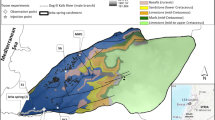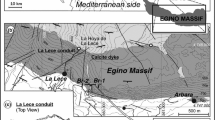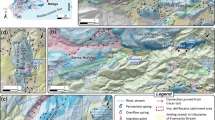Abstract
Karst aquifers are characterized by a high degree of hydrologic variability and spatial heterogeneity of transport parameters. Tracer tests allow the quantification of these parameters, but conventional point-to-point experiments fail to capture spatiotemporal variations of flow and transport. The goal of this study was to elucidate the spatial distribution of transport parameters in a karst conduit system at different flow conditions. Therefore, six tracer tests were conducted in an active and accessible cave system in Vietnam during dry and wet seasons. Injections and monitoring were done at five sites along the flow system: a swallow hole, two sites inside the cave, and two springs draining the system. Breakthrough curves (BTCs) were modeled with CXTFIT software using the one-dimensional advection-dispersion model and the two-region nonequilibrium model. In order to obtain transport parameters in the individual sections of the system, a multi-pulse injection approach was used, which was realized by using the BTCs from one section as input functions for the next section. Major findings include: (1) In the entire system, mean flow velocities increase from 183 to 1,043 m/h with increasing discharge, while (2) the proportion of immobile fluid regions decrease; (3) the lowest dispersivity was found at intermediate discharge; (4) in the individual cave sections, flow velocities decrease along the flow direction, related to decreasing gradients, while (5) dispersivity is highest in the middle section of the cave. The obtained results provide a valuable basis for the development of an adapted water management strategy for a projected water-supply system.
Résumé
Les aquifères karstiques sont caractérisés par un degré élevé de variabilité hydrologique et d’hétérogénéité spatiale des paramètres de transport. Les essais de traçage permettent de quantifier ces paramètres, mais les expériences conventionnelles point à point ne captent pas les variations spatio-temporelles du débit et du transport. L’objectif de cette étude était d’élucider la distribution spatiale des paramètres de transport dans un système de conduits karstiques pour différentes conditions d’écoulement. Par conséquent, six essais de traçage ont été effectués dans un système de grottes actif et accessible au Vietnam pendant les saisons sèches et humides. Les injections et le suivi ont été effectués à cinq endroits le long du système d’écoulement: une perte, deux emplacements à l’intérieur de la grotte, et deux sources drainant le système. Les courbes de restitution (BTCs) ont été modélisées à l’aide du logiciel CXTFIT en utilisant le modèle uni-dimensionnel d’advection-dispersion et le modèle de non équilibre à deux régions. Afin d’obtenir les paramètres de transport dans les différentes sections du système, une approche par injection multi-impulsions a été utilisée, qui a été réalisée en utilisant les BTCs d’une section comme fonctions d’entrée pour la section suivante. Les principales conclusions sont les suivantes: (1) dans l’ensemble du système, les vitesses moyennes d’écoulement augmentent de 183 à 1,043 m/h avec un débit croissant, tandis que (2) la proportion de régions de fluide immobile diminue; (3) la plus faible dispersivité a été trouvée pour le débit intermédiaire; (4) dans les sections individuelles de la grotte, les vitesses d’écoulement diminuent le long du sens de l’écoulement, en rapport avec les gradients décroissants, tandis que (5) la dispersivité est. la plus élevée dans la section médiane de la grotte. Les résultats obtenus constituent une base précieuse pour l’élaboration d’une stratégie de gestion adaptée de l’eau à un projet de système d’approvisionnement en eau.
Resumen
Los acuíferos kársticos se caracterizan por un alto grado de variabilidad hidrológica y heterogeneidad espacial en los parámetros de transporte. Las pruebas de trazadores permiten la cuantificación de estos parámetros, pero los experimentos convencionales punto a punto no logran capturar las variaciones espaciotemporales del flujo y el transporte. El objetivo de este estudio fue dilucidar la distribución espacial de los parámetros de transporte en un sistema de conductos kársticos en diferentes condiciones de flujo. Por lo tanto, se realizaron seis pruebas de trazadores en Vietnam en un sistema de cavernas activo y accesible durante las estaciones secas y húmedas. Las inyecciones y el monitoreo se realizaron en cinco sitios a lo largo del sistema de flujo: un sumidero, dos sitios dentro de la caverna y dos manantiales que drenan el sistema. Las curvas de ruptura (BTCs) se modelaron con el software CXTFIT utilizando un modelo de advección-dispersión unidimensional y un modelo de no equilibrio de dos regiones. Para obtener los parámetros de transporte en las secciones individuales del sistema, se utilizó un enfoque de inyección de múltiples impulsos, que se realizó utilizando los BTCs de una sección como funciones de entrada para la siguiente sección. Los principales hallazgos incluyen: (1) En todo el sistema, las velocidades de flujo promedio aumentan de 183 a 1,043 m/h con un aumento en la descarga, mientras que (2) la proporción de regiones fluidas inmóviles disminuye; (3) la dispersión más baja se encontró en la descarga intermedia; (4) en las secciones individuales de la caverna, las velocidades de flujo disminuyen a lo largo de la dirección del flujo, relacionadas con la disminución de los gradientes, mientras que (5) la dispersividad es más alta en la sección media de la caverna. Los resultados obtenidos proporcionan una base valiosa para el desarrollo de una estrategia de gestión del agua adaptada para el sistema de suministro de agua proyectado.
摘要
岩溶含水层的特征就是水文可变性及传输参数的空间异质性都很高。示踪实验可以量化这些参数,但常规的点到点试验不能获得水流和传输的时空变化。本研究的目的就是阐明不同水流条件下岩溶通道系统中传输参数的空间分布情况。因此,在旱季和雨季期间在越南的一个活跃的、可接近的洞穴系统中进行了六次示踪试验。沿水流系统的五个点上进行了注入和观测:一个落水洞、两个洞穴的点以及两个该系统的排泄泉。用CXTFIT软件采用一维平流-离散模型和二地区非平衡模型模拟了突破曲线。为了获得该系统单个断面的传输参数,采用了多脉冲注入方法,即把一个断面的突破曲线作为下一个断面的输入函数。主要发现包括:(1)在整个系统中,平均水流速度从183 m/h增加到1,043 m/h,同时伴随着排泄增加,(2)而不流动的液体区降低;(3)在排泄量中等时,发现分散率很低;(4)在单个的洞穴断面,水流速度沿水流方向降低,这与坡度增加有关,(5)而在洞穴断面的中部,分散率最高。获取的结果为计划为供水系统的水管理战略的制定提供宝贵的基础。
Resumo
Os aquíferos cársticos estão caracterizados por um alto grau de variabilidade hidrológica e variabilidade espacial no transporte de parâmetros. Os testes com traçadores permitem a quantificação destes parâmetros, porém experimentos convencionais ponto a ponto fracassam na captura de variações espaço-temporais do fluxo e do transporte. O objetivo deste estudo foi o de elucidar a distribuição espacial do transporte de parâmetros em um sistema de condutos cársticos em diferentes condições de fluxo. Assim, foram executados seis testes com traçadores em um sistema de cavidades ativo e acessível no Vietnã durante as estações seca e úmida. Injeções e monitoramentos foram feitos ao longo do sistema de fluxo de cinco locais: um buraco raso, dois locais dentro da caverna e duas nascentes que drenam o sistema. Curvas de identificação (CI) foram modeladas com o software CXTFIT usando o modelo de advecção-dispersão unidimensional e o modelo de não equilíbrio de duas regiões. De forma a obter os parâmetros de transporte nas seções individualizadas do sistema foi feita uma abordagem de injeção de múltiplos de pulsos usando CI de uma seção como funções de entrada para a seguinte seção. Os resultados mais significativos incluem: (1) no sistema inteiro a média das velocidades de fluxo aumentam de 183 para 1,043 m/h com o incremento da descarga, enquanto (2) decai a proporção de regiões fluidas imóveis; (3) a menor dispersão foi encontrada na descarga intermediaria; (4) nas seções de cavernas individuais as velocidades de fluxo diminuem ao longo da direção de fluxo, relacionado à diminuição do gradiente, enquanto (5) a dispersão é a maior no meio da seção da caverna. Os resultados obtidos proporcionaram uma valiosa base para o desenvolvimento de uma adequada estratégia de gerenciamento em sistemas projetados de abastecimento de água.







Similar content being viewed by others
References
Atkinson TC, Smith DI, Lavis JJ, Witaker RJ (1973) Experiments in tracing underground waters in limestones. J Hydrol 19:323–349
Barberá JA, Mudarra M, Andreo B, De la Torre B (2017) Regional-scale analysis of karst underground flow deduced from tracing experiments: examples from carbonate aquifers in Malaga province, southern Spain. Hydrogeol J 26(1):23–40
Bear J (1979) Hydraulics of groundwater. McGraw-Hill, New York
Birk S, Geyer T, Liedl R, Sauter M (2005) Process-based interpretation of tracer tests in carbonate aquifers. Ground Water 43:381–388
Brown MC, Wigley TL, Ford DC (1969) Water budget studies in karst aquifers. J Hydrol 9:113–116
Chen Z, Auler AS, Bakalowicz M, Drew D, Griger F, Hartmann J, Jiang G, Moosdorf N, Richts A, Stevanovic Z, Veni G, Goldscheider N (2017) The world Karst aquifer mapping project: concept, mapping procedure and map of Europe. Hydrogeol J 25:771–785. https://doi.org/10.1007/s10040-016-1519-3
Dewaide L, Bonniver I, Rochez G, Hallet V (2016) Solute transport in heterogeneous karst systems: dimensioning and estimation of the transport parameters via multi-sampling tracer-tests modelling using the OTIS (one-dimensional transport with inflow and storage) program. J Hydrol 534:567–578. https://doi.org/10.1016/j.jhydrol.2016.01.049
Ender A, Goeppert N, Grimmeisen F, Goldscheider N (2017) Evaluation of β-d-glucuronidase and particle-size distribution for microbiological water quality monitoring in Northern Vietnam. Sci Total Environ 580:996–1006. https://doi.org/10.1016/j.scitotenv.2016.12.054
Field MS, Pinsky PF (2000) A two-region nonequilibrium model for solute transport in solution conduits in karstic aquifers. J Contam Hydrol 44:329–351
Ford D, Williams P (2007) Karst hydrogeology and geomorphology. Wiley, Chichester, UK
Geyer T, Birk S, Licha T, Liedl R, Sauter M (2007) Multitracer test approach to characterize reactive transport in karst aquifers. Ground Water 45:36–45
Goeppert N, Goldscheider N (2008) Solute and colloid transport in karst conduits under low-and high-flow conditions. Ground Water 46:61–68
Goldscheider N, Meiman J, Pronk M, Smart C (2008) Tracer tests in karst hydrogeology and speleology. Int J Speleol 37:3. https://doi.org/10.5038/1827-806X.37.1.3
Hauns M, Jeannin P-Y, Atteia O (2001) Dispersion, retardation and scale effect in tracer breakthrough curves in karst conduits. J Hydrol 241:177–193
Käss W (2004) Geohydrologische Markierungstechnik [Geohydrological tracer technique]. Borntraeger, Stuttgart, Germany
Lauber U, Ufrecht W, Goldscheider N (2014) Spatially resolved information on karst conduit flow from in-cave dye tracing. Hydrol Earth Syst Sci 18:435–445. https://doi.org/10.5194/hess-18-435-2014
Luhmann AJ, Covington MD, Alexander SC, Chai SY, Schwartz BF, Groten JT, Alexander EC (2012) Comparing conservative and nonconservative tracers in karst and using them to estimate flow path geometry. J Hydrol 448:201–211
Massei N, Wang HQ, Field MS, Dupont JP, Bakalowicz M, Rodet J (2006) Interpreting tracer breakthrough tailing in a conduit-dominated karstic aquifer. Hydrogeol J 14:849–858
Morales T, de Valderrama IF, Uriarte JA, Antigüedad I, Olazar M (2007) Predicting travel times and transport characterization in karst conduits by analyzing tracer-breakthrough curves. J Hydrol 334:183–198
Mouret C (2004) Asia, southeast In: Gunn J (ed) Encyclopedia of Caves and Karst Science. Fitzroy Dearborn, New York, pp 210–217
Richardson M, Moore RD, Zimmermann A (2017) Variability of tracer breakthrough curves in mountain streams: implications for streamflow measurement by slug injection. Can Water Res J 42:21–37
Runkel RL (1998) One-dimensional transport with inflow and storage (OTIS): a solute transport model for streams and rivers. US Geological Survey, Reston, VA
Runkel RL, Broshears RE (1991) One-dimensional transport with inflow and storage (OTIS): a solute transport model for small streams. CADSWES, Univ. of Colorado, Boulder, CO
Schnegg P-A (2002) An inexpensive field fluorometer for hydrogeological tracer tests with three tracers and turbidity measurement. XXXII IAH and ALHSUD congress on Groundwater and Human Development, Mar del Plata, Argentina, Balkena, Rotterdam, The Netherlands, pp 1484–1488
Stevanovic Z (2015) Karst aquifers-characterization and engineering. Springer, Cham, Switzerland
Tam VT, Batelaan O (2011) A multi-analysis remote-sensing approach for mapping groundwater resources in the karstic Meo Vac Valley, Vietnam. Hydrogeol J 19(2):275–287. https://doi.org/10.1007/s10040-010-0684-z
Tang G, Mayes MA, Parker JC, Jardine PM (2010) CXTFIT/excel–a modular adaptable code for parameter estimation, sensitivity analysis and uncertainty analysis for laboratory or field tracer experiments. Comput Geosci 36:1200–1209
Toride N, Leij FJ, Van Genuchten MT (1993) A comprehensive set of analytical solutions for nonequilibrium solute transport with first-order decay and zero-order production. Water Resour Res 29:2167–2182
Toride N, Leij FJ, Van Genuchten MT (1995) The CXTFIT code for estimating transport parameters from laboratory or filed tracer experiments. US Salinity Laboratory, Riverside, CA
Toride N, Leij FJ, Van Genuchten MT (1999) The CXTFIT code for estimating transport parameters from laboratory or field tracer experiments. Research report no. 137 US Salinity Laboratory, Riverside, CA
Tran HT, Van Dang B, Ngo CK, Hoang QD, Nguyen QM (2013) Structural controls on the occurrence and morphology of karstified assemblages in northeastern Vietnam: a regional perspective. Environ Earth Sci 70:511–520. https://doi.org/10.1007/s12665-011-1057-1
van Genuchten MT, Šimůnek J, Leij FJ, Toride N, Šejna M (2012) STANMOD: model use, calibration, and validation. Am Soc Agric Biol Eng 55(4):1353–1366
Van Nguyen L, Nguyen NK, Van Hoang H, Tran TQ, Vu NT (2013) Characteristics of groundwater in karstic region in northeastern Vietnam. Environ Earth Sci 70:501–510. https://doi.org/10.1007/s12665-012-1548-8
Worthington SR (2009) Diagnostic hydrogeologic characteristics of a karst aquifer (Kentucky, USA). Hydrogeol J 17:1665
Zech A, Attinger S, Cvetkovic V, Dagan G, Dietrich P, Fiori A, Rubin Y, Teutsch G (2015) Is unique scaling of aquifer macrodispersivity supported by field data? Water Resour Res 51:7662–7679
Acknowledgements
We gratefully acknowledge the financial support of the German Federal Ministry of Education and Research (BMBF) [grant number 02WCL1291A]. We want to thank Ha Giang Peoples Committee, Dong Van Peoples Committee as well as the Vietnam Institute of Geosciences and Mineral Resources (Hanoi) for their support during fieldwork. Special thanks are given to the whole sampling team, especially to Arno Hartmann, Marian Bechtel, Philipp Holz, Alexandra Roth, Christian Weippert and Tobias Zaege and to the colleagues from VIGMR. Furthermore, we thank the cavers from the Belgian SPEKUL club, particularly David Lagrou, for their support during the tracer tests and the provision of cave maps and Nguyet Vu Thi Minh, for borrowing the field fluorimeter. We thank Arica Beisaw for proofreading and the associate editor, Prof. Luhmann, as well as the three anonymous reviewers for their valuable comments.
Author information
Authors and Affiliations
Corresponding author
Electronic supplementary material
ESM 1
(PDF 448 kb)
Rights and permissions
About this article
Cite this article
Ender, A., Goeppert, N. & Goldscheider, N. Spatial resolution of transport parameters in a subtropical karst conduit system during dry and wet seasons. Hydrogeol J 26, 2241–2255 (2018). https://doi.org/10.1007/s10040-018-1746-x
Received:
Accepted:
Published:
Issue Date:
DOI: https://doi.org/10.1007/s10040-018-1746-x




